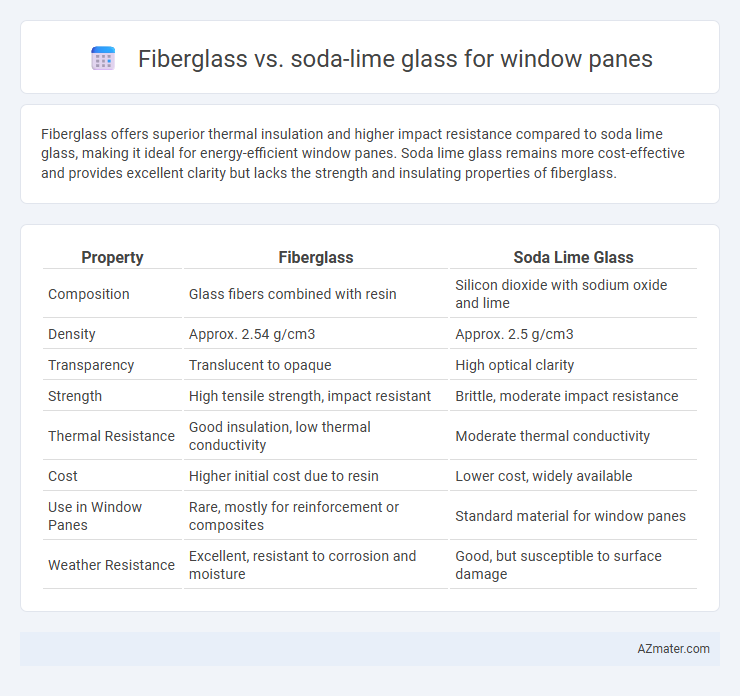Fiberglass offers superior thermal insulation and higher impact resistance compared to soda lime glass, making it ideal for energy-efficient window panes. Soda lime glass remains more cost-effective and provides excellent clarity but lacks the strength and insulating properties of fiberglass.
Table of Comparison
| Property | Fiberglass | Soda Lime Glass |
|---|---|---|
| Composition | Glass fibers combined with resin | Silicon dioxide with sodium oxide and lime |
| Density | Approx. 2.54 g/cm3 | Approx. 2.5 g/cm3 |
| Transparency | Translucent to opaque | High optical clarity |
| Strength | High tensile strength, impact resistant | Brittle, moderate impact resistance |
| Thermal Resistance | Good insulation, low thermal conductivity | Moderate thermal conductivity |
| Cost | Higher initial cost due to resin | Lower cost, widely available |
| Use in Window Panes | Rare, mostly for reinforcement or composites | Standard material for window panes |
| Weather Resistance | Excellent, resistant to corrosion and moisture | Good, but susceptible to surface damage |
Introduction to Window Pane Materials
Fibre glass offers superior strength and flexibility compared to soda lime glass, making it an ideal choice for modern window panes requiring impact resistance and thermal insulation. Soda lime glass is the most common and cost-effective material used for window panes, known for its clarity, ease of manufacturing, and recyclability. Both materials are tailored to different applications, with fibre glass providing enhanced durability and soda lime glass delivering traditional transparency and affordability.
What is Fibre Glass?
Fibre glass, a composite material made from fine glass fibers woven into a mat, offers superior strength and flexibility compared to traditional soda lime glass. It provides enhanced thermal insulation and impact resistance, making it ideal for energy-efficient and durable window panes. Unlike soda lime glass, which is brittle and prone to shattering, fibre glass window panes are lightweight, less prone to breakage, and offer improved longevity in harsh weather conditions.
What is Soda Lime Glass?
Soda lime glass, the most common type of glass used for window panes, consists primarily of silica (sand), soda ash, and limestone, offering excellent durability and clarity at a low cost. Unlike fibreglass, which is a composite material made from glass fibers embedded in resin, soda lime glass provides a rigid, transparent barrier that performs well in terms of thermal insulation and impact resistance. Its widespread use in architectural applications stems from its ease of production, recyclability, and ability to be tempered or laminated for enhanced safety.
Mechanical Strength Comparison
Fiberglass window panes exhibit higher tensile strength and impact resistance compared to soda lime glass, making them more durable under mechanical stress. Soda lime glass, while rigid and adequate for standard use, is more brittle and prone to cracking or shattering upon impact. The enhanced flexibility and toughness of fiberglass provide superior performance in environments subject to mechanical loads or sudden force.
Thermal Insulation Properties
Fiberglass offers significantly better thermal insulation compared to soda lime glass due to its low thermal conductivity, reducing heat transfer and improving energy efficiency in window panes. Soda lime glass, the most common window material, has higher thermal conductivity, leading to greater heat loss and less efficient thermal performance. Choosing fiberglass window panes enhances indoor temperature regulation and lowers heating and cooling costs by minimizing thermal bridging.
Weight and Durability Factors
Fiberglass window panes are significantly lighter than soda lime glass, reducing structural load and easing installation processes. In terms of durability, fiberglass offers superior resistance to impact, thermal stress, and weathering, whereas soda lime glass is more prone to shattering and corrosion over time. The enhanced tensile strength and flexibility of fiberglass make it a preferred choice for long-lasting window applications in demanding environments.
Cost Analysis: Fibre Glass vs Soda Lime Glass
Fiberglass window panes typically cost more upfront than soda lime glass due to higher material and manufacturing expenses but offer superior durability and thermal insulation, which can lower long-term energy costs. Soda lime glass is less expensive initially, making it a cost-effective choice for budget-conscious projects, though it may incur higher maintenance and replacement costs over time. Evaluating total cost of ownership, fiberglass often proves more economical for energy-efficient, long-lasting installations despite its higher initial price.
Aesthetic and Design Considerations
Fiberglass window panes offer a sleek, modern aesthetic with a smooth finish that resists warping and can be painted to match various architectural styles, enhancing design flexibility. Soda lime glass, commonly used in traditional windows, provides clarity and natural light transmission but is more prone to scratches and less adaptable to customized shapes or tints. The choice between fiberglass and soda lime glass depends on the desired balance between contemporary design requirements and classic transparency qualities.
Maintenance and Longevity
Fiberglass window panes exhibit superior maintenance benefits due to their resistance to corrosion, warping, and discoloration, ensuring a longer lifespan compared to soda lime glass. Soda lime glass, commonly used in windows, requires more frequent cleaning and is prone to scratches and breakage, reducing its durability over time. The inherent strength and low thermal expansion of fiberglass contribute to enhanced longevity and reduced upkeep costs in window applications.
Environmental Impact and Sustainability
Fiberglass window panes exhibit lower environmental impact compared to soda lime glass due to their higher thermal insulation properties, which reduce energy consumption for heating and cooling. Soda lime glass, while widely recycled and abundant, has a higher carbon footprint in production and tends to be heavier, increasing transportation emissions. Fiberglass also offers durability and a longer lifespan, reducing the frequency of replacement and associated waste, making it a more sustainable choice for window applications.

Infographic: Fibre glass vs Soda lime glass for Window pane
 azmater.com
azmater.com